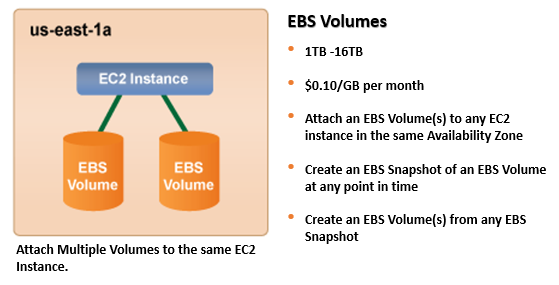EBS Volumes and Device Mapping
EBS volumes are used to provide raw storage disk devices to SoftNAS Cloud® by attaching to the SoftNAS Cloud® instance using the AWS console. The recommended naming convention depends on the virtualization type of device. See the table below for the AWS-recommended device mapping method.
EBS to Linux Device Mapping Table
|
Type of Virtualization
|
Available String Blocks
|
Reserved for Root
|
Instance Store Volumes
|
Recommended for EBS Volumes
|
|
Paravirtual
|
/dev/sd[a-z]
/dev/sd[a-z][1-15]
/dev/hd[a-z]
/dev/hd[a-z][1-15]
|
/dev/sda1
|
/dev/sd[b-e]
|
/dev/sd[f-p]
/dev/sd[f-p][1-6]
|
|
HVM
|
/dev/sd[a-z]
/dev/xvd[b-c][a-z]
|
Differs by AMI
/dev/sda1 or
/dev/xvda
|
/dev/sd[b-e]
/dev/sd[b-y]
(hs1.8xlarge)
|
/dev/sd[f-p]
|
Note: Approval by AWS Support may be required to go beyond the initial 20 TB limit account default.
About EBS Volume Naming
EBS volumes are used to provide raw storage disk devices to SoftNAS. EBS volumes are attached to the SoftNAS instance using the AWS console. The number of disks that can be attached is based on the type of virtualization used - HVM or PV.
HVM
The key restriction of using HVM virtualization is the limit of 11 attachable EBS volumes to your SoftNAS instance. This limit is based on the volume naming convention used by HVM instances. For HVM, AWS supports EBS volume naming of /dev/sd[f-p]. This means that as each EBS volume is attached, it is assign a device name of “/dev/sdf”, then “/dev/sdg”, and so on. Once the recommended name range of “f” through “p” are used, no additional EBS volumes should be attached.
/dev/sd[f-p][1-15]
Even though a-z may appear to work, use of those device names is not supported, and AWS might be using a-g and q-z range at some stage for something else, so for now, it's a good idea to stick with the device names from [f-p] when attaching EBS volumes via AWS console to an HVM instance.
PV
The primary benefit to using PV AMIs to deploy SoftNAS is the ability to attach a much higher count of EBS volumes. This is based on the volume naming convention used by PV virtualization. While HVM only supports limited alpha characters for volume naming, PV supports the ability to add numeric values at the end of the volume name. For PV, AWS supports EBS volume naming of /dev/sd[f-p][1-6]. This means that up to 66 EBS volumes can be attached to a PV instance with a total raw EBS capacity of over 1 petabyte (11*6*16TB = 1.056PB).
For example: USE: /dev/sdf1, /dev/sdf2, /dev/sdf3 ... /dev/sdp5, /dev/sdp6
Note: While it is possible to add 66 EBS volumes as stated above, AWS guidance states that support for configurations above 40 EBS volumes is on a best effort basis.
In the past, PV virtualization performance was much better than that of HVM. With improvements in today’s hardware (IOMMU & SR-IOV), this is no longer the case. AWS has releasing their latest generations of c4 and m4 instances with HVM AMI exclusive support. The c3 and m3 instance families do provide both PV and HVM support, but AWS recommends using HVM AMIs across the board for best performance.
Note: If using a PV instance of SoftNAS, DO NOT USE the /dev/sdf or /dev/sdp base device names, or you will limit the number of EBS volumes that can be attached to a maximum of 11 disks. [F - P ] should always be followed by a number, or you will restrict your instance's EBS add-on volumes.
This means you can assign 66 extra disks to an instance for a maximum of 154 TB of storage space.
Note: Approval from AWS Support may be required to go beyond the initial 20 TB limit that is the default for your account.
|
EBS Mount SoftNAS Linux Mapping
| |
|
|
|
|
/dev/sda1
|
/dev/xvde1 (Root Disk - 30 GB, do not use or partition)
|
|
/dev/sdf1 ... 15
|
/dev/xvdj1 ... xvdj15
|
|
/dev/sdg1 ... sdg15
|
/dev/xvdk1 ... xvdk15
|
|
/dev/sdh1 ... 15
|
/dev/xvdl1 ... 15
|
|
/dev/sdi1 ... 15 /
|
dev/xvdm1 ... 15
|
|
/dev/sdj1 ... 15
|
/dev/xvdn1 ... 15
|
|
/dev/sdk1 ... 15
|
/dev/xvdo1 ... 15
|
|
/dev/sdl1 ... 15
|
/dev/xvdp1 ... 15
|
|
/dev/sdm1 ... 15
|
/dev/xvdq1 ... 15
|
|
/dev/sdn1 ... 15
|
/dev/xvdr1 ... 15
|
|
/dev/sdo1 ... 15
|
/dev/xvds1 ... 15
|
|
/dev/sdp1 ... 15
|
/dev/xvdt1 ... 15
|
About Amazon EBS Disks
Amazon Elastic Block Store (Amazon EBS) provides persistent, block-level storage volumes for use with Amazon EC2 instances in the AWS Cloud. Each Amazon EBS volume is automatically replicated within its Availability Zone to protect from component failure, offering high availability and durability. Amazon EBS and SoftNAS Cloud® provide access to store and retrieve any amount of data, at any time, from anywhere on the web. It gives anyone access to the same highly scalable, reliable, secure, fast, inexpensive infrastructure that Amazon uses to run its own global network of web sites. The service aims to maximize benefits of scale and to pass those benefits on to customers.

As an example: For 1 TB of usable storage with RAID Redundancy for increased performance and data redundancy, one potential configuration could be:
-
Two 1 TB EBS volumes, configured as RAID 1 mirrors
-
Five 250 GB EBS volumes, configured as RAID 5 (four data, single parity)
-
Seven 250 GB EBS volumes, configured as RAID 6 with a spare (four data, dual parity, one spare)
S3 Cloud Disks for Cloud Storage
Use S3 Cloud Disks to manage up to 4 petabytes of Amazon S3 cloud storage per device. For more information on Cloud Disks, refer to the SoftNAS Cloud® Disk Overview section of this guide.
Instance Tags and Key Pairs secure data and verify ownership. Properly set up, these layers of validation protect EC2 Instances from accidental or unauthorized users.